




|
Key to genera of tree crickets (Oecanthinae). |

|
Key to species groups of Oecanthus (common tree crickets). |
For a beautifully illustrated, informative website devoted mostly to Oecanthus, go to http://www.oecanthinae.com/. This site, created by Nancy Collins (an energetic oecanthine enthusiast), is organized into more than 20 sections and has impressive still photos and videos.
North American species of Oecanthus fall into four groups based on numerous characters including markings and swellings on the first and second antennal segments and male-limited characters such as calling songs, proportions of the dorsal field of the forewings, and features of the metanotal glands. (These glands, sometimes termed "honey pots," are exposed during calling and courtship.) After the female mounts the male to receive a spermatophore, she spends 5-15 minutes feeding on the secretions of these glands.
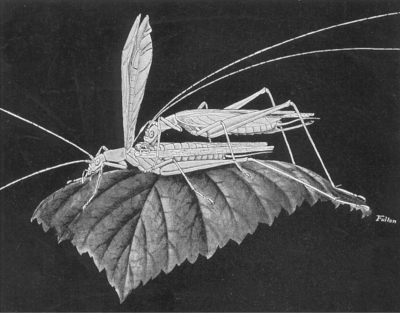
|
Oecanthus niveus female feeding on a male's metanotal gland.
Drawing by B. B. Fulton (Fulton 1915).
There are four Oecanthus species groups on SINA: rileyi niveus nigricornis varicornis
There are three species in the rileyi group within the area covered by SINA:
Oecanthus fultoni (snowy tree cricket) occurs widely but is less common in the deep-southeastern U.S. and far-northern reaches of the Great Plains and Great Lakes. O. rileyi (Riley's tree cricket) is known only from states along or west of the continental divide. These two species also occur in Canada. Differences in the markings on the first two antennal segments easily separate these two species in nearly all cases. The third species, O. alexanderi (Alexander’s tree cricket), is known in the U.S. only from the lower Rio Grande valley and was formally described in 2010 by Walker & Collins.
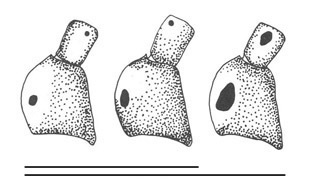
|

|
| rileyi | fultoni |

|
|
| alexanderi | |
Variation in the antennal markings of the three species in the rileyi group. In each group of three drawings, the two on the left are representative of the markings of most specimens of the species.
There are three species in the niveus group within the area covered by SINA:
exclamationis leptogrammus niveus
These three species are easily identified on the basis of the markings on the first two antennal segments. O. niveus (narrow-winged tree cricket) has a J-shaped mark on the first antennal segment; O. exclamationis (Davis's tree cricket) has a broad straight mark on the first antennal segment, which becomes part of an exclamation mark when viewed with the mark on the second segment; and O. leptogrammus (thin-lined tree cricket) has narrow straight lines on the first and second antennal segments.
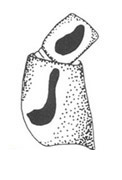
|
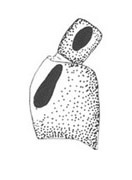
|
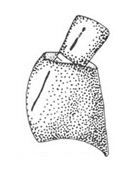
|
| niveus | exclamationis | leptogrammus |
There are nine species in the nigricornis group within the area covered by SINA:
argentinus beameri celerinictus forbesi laricis nigricornis pini quadripunctatus salvii walkeri
Most members of this group occur predominantly in herbaceous vegetation and hence are more readily collected than tree-inhabiting tree crickets. However, two species inhabit coniferous trees and their color, as well as their habitats, set them apart (see below). The two conifer-inhabiting species, O. pini (pine tree cricket) and O. laricis (tamarack tree cricket), can be recognized by their brown heads and thorax and green or green-tinged wings, which make them difficult to spot when they rest with their heads next to the boughs with their rears amidst the needles. While O. laricis is known only from tamarack and hemlock, O. pini can be found on pine, spruce, juniper, cedar, fir, and yew, as well as tamarack and hemlock.

|
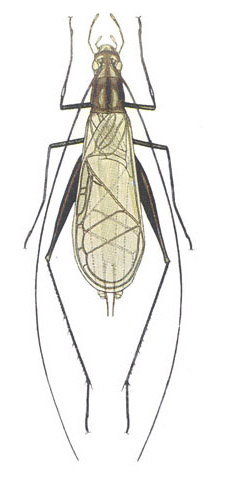
|
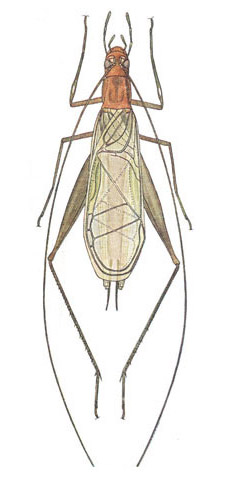
|
| most common | frequent in nigricornis and forbesi | only in pini and laricis |
Colors among members of nigricornis species group.
Drawings by B. B. Fulton (Fulton 1915).
The herb-inhabiting species of the nigricornis group are sometimes difficult to identify, and they exhibit interesting and poorly understood variations in the plants they inhabit. In the case of O. nigricornis (black-horned tree cricket) and O. forbesi (Forbes's tree cricket), the only identifying feature is the (temperature-dependent) pulse rate of the male calling song. This makes females and dead males identifiable only by their association with males of known song type—and sometimes, at least in central Ohio, the two species occur together. That said, with the exception of nigricornis vs. forbesi, the markings on the first two antennal segments provide a good means of identifying most specimens of the herb-inhabiting species of the nigricornis group.
There are three species which are mostly green that can be challenging to differentiate if the black antennal markings are not able to be inspected: O. argentinus (prairie tree cricket), O. celerinictus (fast-calling tree cricket), and O. quadripunctatus (four-spotted tree cricket).
One species in the nigricornis species group that does inhabit trees is O. walkeri (Walker’s tree cricket). They are found generally near the Mexican border from Texas to Arizona, are particularly fond of willows, and have been heard singing 12 feet and higher above ground. Another species, O. salvii (sage tree cricket), has been found only on sagebrush and rabbitbrush in western North America, ranging from California to British Colombia.
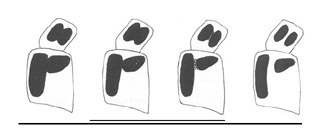
|
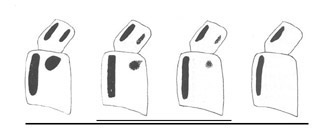
|
| argentinus | quadripunctatus |
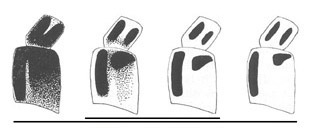
|
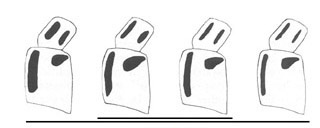
|
|
| nigricornis / forbesi | celerinictus |

|
| beameri |

|

|

|
| pini | salvii | walkeri |
Variation in the antennal markings of the species in the nigricornis group. In each group of the first four drawings, the two at center are representative of the markings of most specimens of the species.
It is important to understand that when these herb-inhabiting species are collected by sweeping a net through the vegetation on which they occur, two or even three species may be among the catch. When the two are O. quadripunctatus (four-spotted tree cricket) and O. celerinictus, as in the Southeast, or O. quadripunctatus and O. argentinus (prairie tree cricket), as in the Midwest, there is little to suggest that more than one species is present until the antennal marks are examined. On the other hand when the two are quadripunctatus and nigricornis, as in the Northeast, the differing overall coloration of the two separates the two without reference to the antennal markings. In this regard, it must be noted that the overall coloration of nigricornis and forbesi is often intermediate between the first two of the three color modes illustrated above.
It should also be noted that the herb-inhabiting species of the nigricornis group are sometimes found on woody plants. Males may call from the lower branches of small trees in open areas, and in some cases both sexes seem at home on woody plants such as willow and sumac.
From: Collins and Lightfoot 2022.
| 1a | Sternites with dark black, brown, rust, or burgundy. | 2 |
| 1b | Sternites white/cream/pale green or with very pale reddish brown blocks. | 5 |
| 2a | Pronotum mostly brown/rust. | 3 |
| 2b | Pronotum green, mostly black, or greenish with prominent dark strip/s. | 4 |
| 3a | Antennae, head, pronotum, and sternites dark brown color; hosts tamarack and hemlock; length of tegmina < 12 mm. | O. laricis |
| 3b | Antennae, head, pronotum, and sternites rust color; hosts are most conifers; length of tegmina > 12 mm. | O. pini |
| 4a | Song pulse rate > 70 pulses per second at 77°F/25°C; frequency > 4.1 kHz at 55 pulses per second; buzzy trilling song; usually with one or two lateral lines on hind tibiae; may be all green, but sternite still black or burgundy; generally in or west of Ohio. | O. forbesi |
| 4b | Song pulse rate < 65 pulses per second at 77°F/25°C; frequency < 4.0 kHz at 55 pulses per second; usually with one or two lateral lines on hind tibiae; may be all green, but sternites still black or burgundy; generally in or east of Ohio. | O. nigricornis |
| 5a | Overall light or medium green color, but not pale greenish-white. | 6 |
| 5b | Overall pale greenish-white color. | 9 |
| 6a | Lateral mark on scape round or with a slight outward point (may be absent); frequency > 4.2 kHz at 55 pulses per second; male tegminal length > 10 mm; male subgenital plate tapers to a wide point; female subgenital plate with a deep narrow notch; no dark lateral lines on hind tibiae; flute-like trilling song. | O. quadripunctatus |
| 6b | Lateral mark on scape elongated with outward point. | 7 |
| 7a | Black marks on pedicel of equal lengths and widths and touch each other. | 8 |
| 7b | Black marks on pedicel of different lengths and widths and do not touch each other. | 9 |
| 8a | Marks on pedicel touch at bottom to form a V; black rings on antennal segments beyond pedicel; eyes yellow; lateral borders of pronotum always white; prefer narrow-leafed trees and shrubs (e.g., willow, tepejuage). | O. walkeri |
| 8b | Marks on pedicel touch in center; all four antennal markings thick and dark black; antennal segments beyond pedicel with or without black rings; eye color varies; generally not found in trees. | O. argentinus |
| 9a | Antennal segments beyond pedicel with black or dark grey rings beyond pedicel; male tegminal length > 10 mm; hind femora with numerous dark black setae. | O. salvii |
| 9b | Antennal segments beyond pedicel without rings or with light brown, pale green or greenish-white rings beyond pedicel; male tegminal length < 10 mm; no dark black setae on hind femora. | 10 |
| 10a | Medial mark on scape a solid vertical line; always has lateral antennal markings on both pedicel and scape; one or two lateral lines on tibiae (two hind tibiae most common, but can be four or all six); pale green. | O. celerinictus |
| 10b | Medial mark on scape usually an interrupted vertical line; outer marks on pedicel and scape usually absent or very faint (some individuals match four antennal markings of O. quadripunctatus); lateral tibial lines usually not present or barely visible; pale greenish-white. | O. beameri |
There are five species in the varicornis group within the area covered by SINA:
O. californicus O. latipennis O. major O. texensis O. varicornis
All males in the varicornis species group have very wide tegmina. One species, O. latipennis (broad-winged tree cricket), is found east of the continental divide, and the other four species are found from Texas to Montana and west. The four species in the west are O. varicornis (different-horned tree cricket), O. californicus (western tree cricket), O. major (great tree cricket), and O. texensis (Texas tree cricket). These four species have varying degrees of red on the head with black antennae. Only O. latipennis lacks black, has red or pink running up the antennae, and is the only one of the five species that does not have a brown form.
Oecanthus major is known only from the southeast corner of Arizona and O. varicornis is known only from Texas and western Louisiana. The species with the largest range is O. californicus with U.S. encounters from California to Texas and Washington to Montana, as well as in southwest Canada. The range of O. texensis is not fully understood as it has been documented in Texas to California as well as in Idaho. With similar ranges and appearances, these four species can be difficult to ID from photos.
Last update: May 2022
Contributor: Nancy Collins